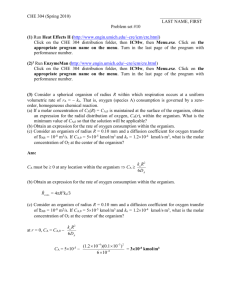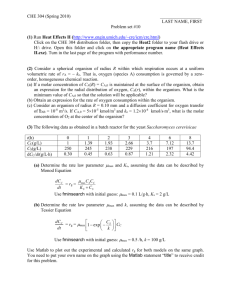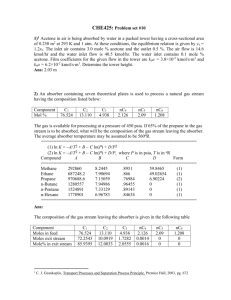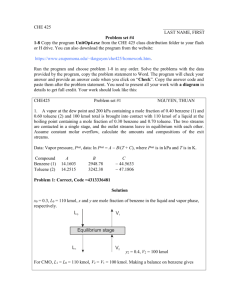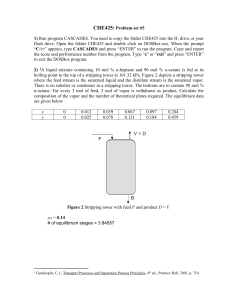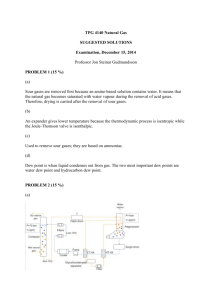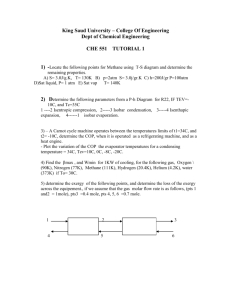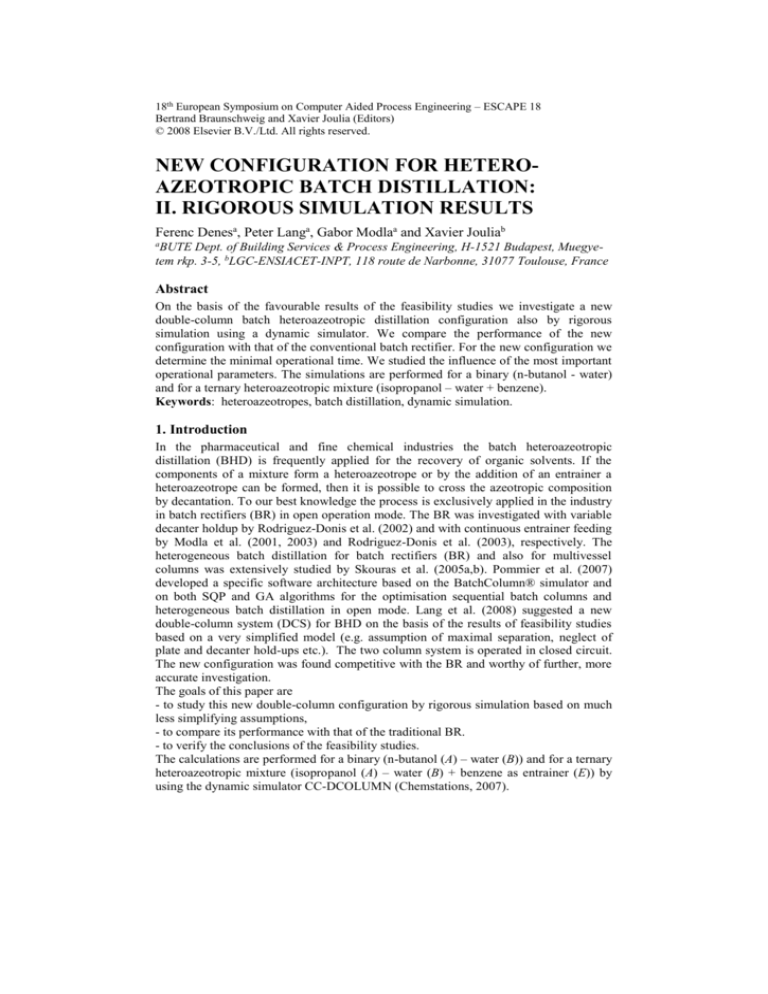
18th European Symposium on Computer Aided Process Engineering – ESCAPE 18
Bertrand Braunschweig and Xavier Joulia (Editors)
© 2008 Elsevier B.V./Ltd. All rights reserved.
NEW CONFIGURATION FOR HETEROAZEOTROPIC BATCH DISTILLATION:
II. RIGOROUS SIMULATION RESULTS
Ferenc Denesa, Peter Langa, Gabor Modlaa and Xavier Jouliab
a
BUTE Dept. of Building Services & Process Engineering, H-1521 Budapest, Muegyetem rkp. 3-5, bLGC-ENSIACET-INPT, 118 route de Narbonne, 31077 Toulouse, France
Abstract
On the basis of the favourable results of the feasibility studies we investigate a new
double-column batch heteroazeotropic distillation configuration also by rigorous
simulation using a dynamic simulator. We compare the performance of the new
configuration with that of the conventional batch rectifier. For the new configuration we
determine the minimal operational time. We studied the influence of the most important
operational parameters. The simulations are performed for a binary (n-butanol - water)
and for a ternary heteroazeotropic mixture (isopropanol – water + benzene).
Keywords: heteroazeotropes, batch distillation, dynamic simulation.
1. Introduction
In the pharmaceutical and fine chemical industries the batch heteroazeotropic
distillation (BHD) is frequently applied for the recovery of organic solvents. If the
components of a mixture form a heteroazeotrope or by the addition of an entrainer a
heteroazeotrope can be formed, then it is possible to cross the azeotropic composition
by decantation. To our best knowledge the process is exclusively applied in the industry
in batch rectifiers (BR) in open operation mode. The BR was investigated with variable
decanter holdup by Rodriguez-Donis et al. (2002) and with continuous entrainer feeding
by Modla et al. (2001, 2003) and Rodriguez-Donis et al. (2003), respectively. The
heterogeneous batch distillation for batch rectifiers (BR) and also for multivessel
columns was extensively studied by Skouras et al. (2005a,b). Pommier et al. (2007)
developed a specific software architecture based on the BatchColumn® simulator and
on both SQP and GA algorithms for the optimisation sequential batch columns and
heterogeneous batch distillation in open mode. Lang et al. (2008) suggested a new
double-column system (DCS) for BHD on the basis of the results of feasibility studies
based on a very simplified model (e.g. assumption of maximal separation, neglect of
plate and decanter hold-ups etc.). The two column system is operated in closed circuit.
The new configuration was found competitive with the BR and worthy of further, more
accurate investigation.
The goals of this paper are
- to study this new double-column configuration by rigorous simulation based on much
less simplifying assumptions,
- to compare its performance with that of the traditional BR.
- to verify the conclusions of the feasibility studies.
The calculations are performed for a binary (n-butanol (A) – water (B)) and for a ternary
heteroazeotropic mixture (isopropanol (A) – water (B) + benzene as entrainer (E)) by
using the dynamic simulator CC-DCOLUMN (Chemstations, 2007).
2
F. Denes et al.
2. Simulation method
When making rigorous simulation calculations the following simplifying assumptions
are applied:
- theoretical trays,
- constant volumetric liquid holdup on the trays and in the decanter,
- negligible vapour holdup,
- negligible duration of pumping between the two steps (BR).
The model equations to be solved are well-known:
a. Non-linear differential equations (material balances, heat balances)
b. Algebraic equations (VLE, LLE relationships, summation equations, hold-up and
physical property models).
For describing phase equilibria the NRTL (for the binary mixture) and UNIQUAC
model are applied. For the solution of the above equations the dynamic simulator of
ChemCad 5.6 (program CC-DCOLUMN) is applied. Column sections are modelled by
the module DYNAMIC COLUMN, reboilers and the (vertical cylindrical flat bottom)
decanter by the DYNAMIC VESSEL, respectively (Fig. 1). Besides these units the
flow-sheet still contains HEAT EXCHANGERs (condensers), MIXERs and
DIVIDERs.
Fig.1. The ChemCad model of the new double-column configuration
3. Simulation results
In each case the total number of theoretical stages (N) without the condenser, decanter
and reboiler is 10 for both configurations. The separation is performed at atmospheric
pressure. Both reflux and distillate (BR) are homogeneous. In the decanter (D=0.5 m)
the volume of liquid phases are prescribed constant (after the start-up). The ratio of the
volumes of the two phases is equal to that of the binary/ternary heteroazeotrope. The
holdup of the plates is taken ~ 1 % of the initial liquid volume in the reboiler of the
given column. In each case the amount of charge (Uch) is 100 kmol and the prescribed
purity of both products is 99.5 mol%. The calculations are started with dry plates and
decanter.
For both configurations when an entrainer is applied there is an optimal amount of E for
which the (total) duration of the production cycle is minimal. For the DCS the duration
of the distillation in the two columns can be also influenced by the division of the total
NEW CONFIGURATION FOR HETEROAZEOTROPIC BATCH DISTILLATION:
II. RIGOROUS SIMULATION RESULTS
3
number of plates (N/N), total heat duty (Q/Q), and the amount of charge (Ub/Uch). In
this paper for each configuration we publish the results only for the optimal case with
minimal duration. For the DCS this means that the prescribed purity is reached in both
columns at the same time.
First the separation of a binary heteroazeotropic mixture (n-butanol - water) by the
different configurations then that of a binary homoazeotrope (isopropanol-water +
benzene as entrainer) is studied.
3.1. Separation of a binary heteroazeotropic mixture
Three different charge compositions are studied:
1. Homogeneous charge rich in n-BuOH (A), xch,A = 0.90
2. Homogeneous charge rich in water (B), xch,A = 0.01
3. Heterogeneous charge, xch,A = 0.30
The prescribed levels of the decanter: B-rich phase: 0.1676 m, A-rich phase: 0.6 m
3.1.1. Homogeneous charge rich in A
The (total) heat duty (Q) is10 MJ/min in each case. (The charge (feed) volume is 8.360
m3.) First the BR then the DCS will be studied, finally the two configurations will be
compared.
In the BR in Step 1 A is produced as bottom residue (Table 1). (When in Step 1 we tried
to produce B we did not reach the prescribed purity at all.) Step 2 is very short since the
amount of distillate (B-rich phase) in Step 1 is very low (7.3 mol% of the charge) and
the A-content of this distillate, which must be removed in Step 2, is also very low (1.2
mol %).
In column of the DCS the heat duty and the amount of liquid to be distilled is much
higher than in the other column due to the high content of A of the charge and because
the B-rich phase purified in column β hardly contains A.
Comparing the two different configurations we can state that
-The duration of the process is shorter by 8% for the BR.
-However for the BR the amount of by-products is higher by 15%.
-The recovery of A is higher for the DCS (94.5 % instead of 89.9 %).
3.1.2. Homogeneous charge rich in B
The total heat duty: Q = 16 MJ/min in each case. (The charge volume is 1.874 m3.)
a.Batch rectifier
In the BR B is produced in Step 1 as bottom residue. (If in Step 1 we try to produce A
the prescribed purity can not be reached at all.) Since in the charge the amount A is very
low the bottom residue reached the prescribed purity of B before filling up the decanter.
(The majority of A appears in the column hold-up.) Since the amount of distillate in
Step 1 is zero there is no need for Step 2.
In the DCS (similarly to the BR) A of prescribed purity can not be produced at all, A
accumulates in the hold-up. In column α the heat duty and the amount of liquid to be
distilled is much lower than in the other column due to the low content of A in the
charge.
Comparing the two different configurations we can state that
-The duration of the process is almost the same for the two different configurations
(BR: 0.15 h, DCS: 0.18 h).
-The recovery of B is similar for the BR (97.57 %) and DCS (97.01 %).
4
F. Denes et al.
BR
DCS
Step 1
Step 2
Total Column Column
Division of feed
kmol
99.1
0.9
Heat duty
MJ/min
10
10
9.4
0.6
3
Plate holdup
80
2
80
10
dm /plate
4.23
Duration
hour
3.85
0.04
3.89
Product A
kmol
81.336
0.000
81.336
85.521
0.000
Product B
kmol
0.000
6.776
6.776
0.000
4.419
0.000
Distillate
kmol
7.282
0.000
0.000
Dist. compn.
mol% A
1.13
7.065
Column holdup
kmol
8.387
0.017
8.404
58.31
Col. hup compn.
mol% A
98.02
2.995
Decanter holdup
kmol
2.995
0.489
3.484
25.62
Dec. hup compn. mol% A
25.62
20.20
10.060
Byproducts
kmol
11.382
0.506
11.888
Table 1. Optimal parameters and results for the binary mixture rich in A (Nα=Nβ=5)
3.1.3. Heterogeneous charge
The total heat duty is Q = 12 MJ/min in each case. (The charge volume is 3.988 m3.)
Before the distillation the charge is separated into two liquid phases:
A-rich: Ubα = 51.8 kmol xA = 0.568
B-rich: Ubβ = 48.2 kmol xA = 0.012
In the BR both components could be produced in Step 1. If A is produced first we get
better results (Table 2). Step 2 is very short since the amount of distillate (B-rich phase)
in Step 1 is low (20.4 mol% of the charge) and the A-content of this distillate, which
must be removed in Step 2, is very low (1.2 mol %).
In the DCS the heat duty of column α (95.6 %) is much higher than in the other column
due to the high content of B (43.2 mol%) whilst the B-rich phase purified in column β
hardly contains A (1.2 mol%). In this case the charge must be divided almost half-andhalf between the two reboilers.
Comparing the two different configurations we can conclude that
-The duration of the process is slightly shorter (by 5%) for the BR.
-However for the BR the amount of by-products is higher (9.2 % vs. 7.6 %).
-The recovery of A is higher for the DCS (89.4 % instead of 82.7 %).
3.2. Separation of a binary homoazeotrope by using an entrainer
The total heat duty is 12 MJ/min in each case. (The volume of the charge is 5.690 m3.)
The charge composition studied is that of the binary homoazeotrope isopropanol (A)water (B): xch,A=67.4 mol%. The prescribed levels of the decanter: B-rich phase: 0.0384
m, E-rich phase: 0.6 m.
For the BR the optimal amount of E by which the duration of Step 1 (determining
primarily the duration of the production cycle) is minimal: 4.2 kmol (0.371 m3). In Step
1 A is produced (Table 3). The duration of this step is much longer than that of Step 2.
Though the amount of distillate (B-rich phase) in Step 1 is not too low (36.4 mol% of
the charge) but the E-content of this distillate, which must be removed (together with A)
in Step 2, is very low (0.35 mol %). In Step 2 B is purified not only from E but also A in
the form of binary azeotrope A-B whose A-content is relatively high.
For the DCS the optimal division of the total number of plates is rather unequal. (In all
binary cases studied the influence of the division of the plates is slight on the results.)
NEW CONFIGURATION FOR HETEROAZEOTROPIC BATCH DISTILLATION:
II. RIGOROUS SIMULATION RESULTS
5
BR
DCS
Step 1
Step 2
Total Column Column
Division of feed
kmol
51.8
48.2
Heat duty
MJ/min
12
12
11.47
0.53
3
Plate holdup
30
10
30
10
dm /plate
3.50
Duration
hour
3.15
0.18
3.33
Product A
kmol
24.948
0.000
24.948
26.948
0.000
Product B
kmol
0.000
65.851
0.000
65.449
0.000
Distillate
kmol
20.360
0.000
0.000
Dist. compn.
mol% A
1.13
4.608
Column holdup
kmol
3.497
0.246
3.743
45.23
Col. hup compn.
mol% A
2.995
Decanter holdup
kmol
2.995
2.463
5.458
25.62
Dec. hup compn. mol% A
25.62
20.62
7.603
Byproducts
kmol
6.492
2.709
9.201
Table 2. Optimal parameters and results for the binary heterogeneous mixture (Nα=Nβ)
BR
DCS
Step 1
Step 2
Total Column Column
Division of feed
kmol
77.0
23.0
Heat duty
MJ/min
12
12
11.06
0.94
3
Plate holdup
60
10
60
20
dm /plate
Entrainer
kmol
4.2
0.0
3.9
0.0
34.70
Duration
hour
35.60
0.85
36.45
Product A
kmol
55.972
0.000
55.972
57.455
0.000
Product B
kmol
0.000
23.586
0.000
27.538
0.000
Distillate
kmol
36.434
10.230
10.230
mol% A
11.94
40.89
Dist. compn.
mol% B
87.71
56.25
17.272
Column holdup
kmol
10.187
2.378
12.565
51.02
mol% A
67.18
Col. hup compn.
24.08
mol% B
0.83
1.635
Decanter holdup
kmol
1.607
0.240
1.847
34.20
mol% A
31.99
11.23
Dec. hup compn.
22.58
mol% B
21.90
88.77
18.907
Byproducts
kmol
11.794
12.848
24.642
Table 3. Optimal parameters and results for the ternary mixture (Nα=4Nβ)
The optimal amount of E: 3.9 kmol. The total amount of E is filled in reboiler α. The
heat duty in column α (92.2 %) is much higher than in the other column. The A-content
of the top vapour of column β is relatively high. In this case 77% of the charge must be
filled in the reboiler α.
Comparing the two different configurations we can conclude that
-The duration of the process is slightly shorter for the DCS
-The recovery of both components is somewhat higher for the DCS.
The evolution of liquid compositions in the reboilers for both configurations is shown in
Fig. 2.
6
F. Denes et al.
Fig. 2 The evolution of liquid compositions in the reboiler(s) (ternary mixture)
4. Conclusion
We investigated a new double-column batch heteroazeotropic distillation configuration
by rigorous simulation using a dynamic simulator. We compared the performance of the
new configuration with that of the conventional batch rectifier. For the new
configuration we determined the minimal operational time. The simulations were
performed for a binary (n-butanol - water) and for a ternary heteroazeotropic mixture
(isopropanol – water + benzene). According to the results of feasibility studies the new
double column system (DCS) proved competitive with the batch rectifier (BR). For the
binary mixture DCS gave similar and for the ternary one better performance than the
BR. Because of its performance and simple operation DCS appears to have high
potential and deserves further investigations (further mixtures, closed loop control etc.).
References
Chemstations, (2007). CHEMCAD user guide.
Lang P., F. Denes and X. Joulia, (2008). New configuration for hetero-azeotropic batch
distillation: I. Feasibility studies, ESCAPE-18, Lyon, France.
Modla G., P. Lang and K. Molnar, (2001). Batch Heteroazeotropic Rectification.... 6th World
Congress of Chemical Engineering, Melbourne, Australia (10 pages on CD).
Modla G., P. Lang , B. Kotai and K. Molnar, (2003). Batch Heteroazeotropic Rectification of a
Low Relative Volatility Mixture, AIChE Journal, 49 (10), 2533.
Prosim SA. http://www.prosim.net (2005).
Pommier S., S. Massebeuf, B. Kotai, P. Lang, O. Baudouin , P. Floquet, V. Gerbaud (2008).
Heterogeneous Batch Distn Processes: Real System Optimisation, CEP, 47, 408-419.
Rodriguez-Donis I, V. Gerbaud and X. Joulia, (2002). Feasibility of Heterogeneous Batch
Distillation Processes, AIChE Journal, 48 (6), 1168.
Rodriguez-Donis Y., J. A. Equijarosa, V. Gerbaud and X. Joulia, (2003). Heterogeneous Batchextractive Distillation of Minimum Boiling Azeotropic Mixtures, AIChE J., 49 (12), 3074.
Skouras S., V. Kiva and S. Skogestad, (2005a). Feasible separations …Chem Eng Sci, 60, 2895.
Skouras S., S. Skogestad and V. Kiva, (2005 b). Analysis and Control of Heteroazeotropic Batch
Distillation, AIChE Journal, 51 (4), 1144-1157.


